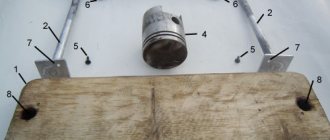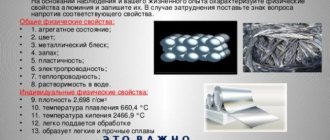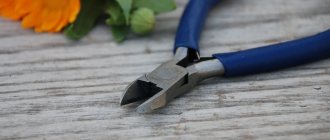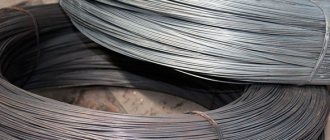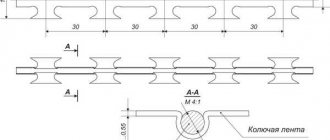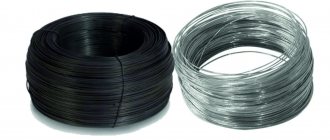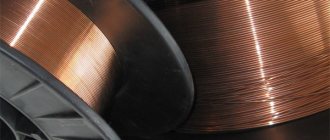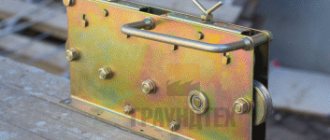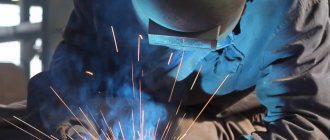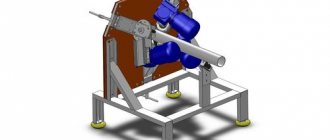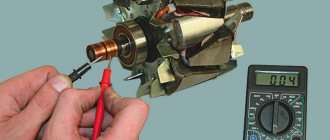When installing electrical wiring, it is necessary to ensure that the actual cross-section of the conductor corresponds to that specified in the project. Since this parameter determines the resistance to electric current, and if there is a discrepancy, overheating and a risk of fire will occur. In practice, there are situations when the purchased wire is not marked at all or the electrician has doubts about the compliance of the declared characteristics with the actual ones. In this case, you need to know how to determine the cross-section of the wire at the work site.
Why does the discrepancy occur?
Despite the fact that in the conditions of modern competition, manufacturers are doing their best not to lose their customers, some of them resort to deception. To do this, they save metal by reducing the diameter. It is enough to remove just a couple of square millimeters, and over hundreds of kilometers of cable this will pay off with a significant reduction in cost.
And then the price will be reduced for the buyer, and they themselves will be satisfied. But the consumer ultimately puts himself at risk due to the fact that the conductor resistance is much lower than stated. And in the place where such a wire is laid, there is a risk of fire.
Conventional graphic designation of a fuse
The conventional graphic designation of a fuse in the diagrams is similar to the designation of resistance, and differs only in that the line passes through the middle of the rectangle without breaking. Next to the symbol, the letter Pr is usually written. or F. Sometimes the diagrams simply write thermal fuse or fuse. After the letter, the protection current of the fuse is often indicated, for example F 1 A, means that the circuit has a fuse for a protection current of 1 ampere.
During operation, fuses fail and have to be replaced with new ones. It is believed that fuses cannot be repaired. But if you approach the repair process competently, then almost any fuse can be successfully repaired and reused. After all, the fuse body remains intact, and only a thin calibrated wire located inside the body burns out. If the burnt wire is replaced with the same one, the fuse will continue to serve.
Methods for determining wire cross-section step by step
There are several ways to measure the cross-section by core diameter. If the wire is single-core, then measurements will be made immediately on it, but one conductor must be untangled from the cable coil. After this, it is cleared of insulation so that only metal remains.
Rice. 1: Removing the insulation from the wire
To calculate the area of a circle through the radius, use the formula: S = π × R 2, where:
- π – constant equal to 3.14;
- R is the radius of the circle.
But, due to the fact that from a practical point of view it is much easier to calculate a diameter equal to two radii, the calculation formula will take the following form: S = π × (D/2) 2.
Rice. 2: Wire diameter
Depending on the methods for measuring the diameter, such methods for calculating the cross section are distinguished.
By diameter using a caliper or micrometer
The most relevant option to measure the diameter are instruments such as calipers and micrometers. These devices allow you to measure the diameter as accurately as possible. To do this you will need a wire and a micrometer
Rice. 3: Wire and micrometer
Consider an example of determining the cross-section for a single-core wire (Figure 4).
Rice. 4: Micrometer measurement
To do this, latch B is moved to the open position. The micrometer handle is unscrewed to such a distance that the wire easily fits in the space between probes A. Then, using handle G, the device is twisted until the ratchet operates. After this, readings are recorded on all three scales at point B.
In this example, the diameter is 1.4 mm, therefore, to calculate the cross-section, you need S = 3.14 × 1.4 × 1.4 / 4 = 1.53 mm 2. The same procedure for determining the cross section can be performed using a caliper.
The advantage of this method is the ability to measure any round conductor, even if it is already installed and used to power any electrical device. The main disadvantage of the method is the high cost of the devices; naturally, purchasing them for a couple of measurements is completely impractical.
By diameter using a pencil or pen
This method of determining the cross-section is based on the fact that the wire has the same diameter along its entire length. Take a regular pencil, pen or felt-tip pen and wrap the wire around it in a spiral. To eliminate the thickness of the insulation, it must be cut along its entire length. The rings should be placed as tightly as possible; the larger the space between the rings, the lower the accuracy.
Rice. 5: Defining the section with a pencil
Since all wires have the same thickness, to determine the diameter of the copper wires, measure the length of the entire winding and divide by the number of turns. In this example, D = 15 mm / 15 turns = 1 mm, respectively, using the same calculation formula, we obtain a section S = 3.14 × 1 × 1 / 4 = 0.78 mm 2. Note that the more turns you make, the more accurately you determine the cross-section.
It is worth noting that the advantage of this method is that only available means can be used to determine the cross-section. The disadvantage is low accuracy and the ability to wind only thin conductors. In the example, a relatively thin wire was used, but the distance between the turns is already visible. Because of which the accuracy leaves much to be desired, it goes without saying that aluminum wire cannot be bent in this way.
By diameter using a ruler
Let’s immediately make a reservation that for measuring with a ruler you can only take a relatively thick wire; the smaller the thickness, the lower the accuracy. The diameter of the vein can be determined by thread or paper; the second option is the most preferable, as it gives greater accuracy.
Rice. 6: Preparing paper for measuring
Tear off a small strip and fold it over on one side. Thinner paper is preferable, so there is no need to fold the sheet several times.
Figure 7: Paper wrapping
Then the paper is applied to the wire and wrapped around the circumference until the strip touches. At the point of contact, it is bent a second time and applied to the ruler for measurement.
Figure 8: Measuring with a ruler
Using the resulting circumference L, the vein diameter D = L / 2 π is found, and the cross section is calculated as shown earlier. This method of determining the cross-section is well suited for large aluminum conductors. But the accuracy in this method is the lowest.
By diameter using ready-made tables
This method is suitable for standard gauge wires. For example, you have already determined the diameter using one of the above methods. Then you use the table to determine the section.
Table 1: determination of cross-section through wire diameter
| Conductor diameter | Conductor cross-section |
| 0.8 mm | 0.5 mm 2 |
| 0.98 mm | 0.75 mm 2 |
| 1.13 mm | 1 mm 2 |
| 1.38 mm | 1.5 mm 2 |
| 1.6 mm | 2.0 mm 2 |
| 1.78 mm | 2.5 mm 2 |
| 2.26 mm | 4.0 mm 2 |
| 2.76 mm | 6.0 mm 2 |
| 3.57 mm | 10.0 mm 2 |
| 4.51 mm | 16.0 mm 2 |
| 5.64 mm | 25.0 mm 2 |
Read also: Do-it-yourself wooden tool box
For example, if your diameter is 1.8 mm, this means that the cross-section according to the table will be equal to 2.5 mm 2.
By power or current
If the conductivity of the core is known, then the cross-section can be determined using it. To do this, you will need one of the parameters of the conductor - current or power. The same can be done if you can calculate the load. Then you must select the appropriate option from the tables below. But it is necessary to take into account whether the wire is made of aluminum or copper conductors.
Table 2: to select the cross-section of the copper wire, depending on the current consumed
| Maximum rated current, A | 1,0 | 2,0 | 3,0 | 4,0 | 5,0 | 6,0 | 10,0 | 16,0 | 20,0 | 25,0 | 32,0 | 40,0 | 50,0 | 63,0 |
| Standard cross-section of copper wire, mm 2 | 0,35 | 0,35 | 0,50 | 0,75 | 1,0 | 1,2 | 2,0 | 2,5 | 3,0 | 4,0 | 5,0 | 6,0 | 8,0 | 10,0 |
| Wire diameter, mm | 0,67 | 0,67 | 0,80 | 0,98 | 1,1 | 1,2 | 1,6 | 1,8 | 2,0 | 2,3 | 2,5 | 2,7 | 3,2 | 3,6 |
Table 3: to select the cross-section of copper wire, depending on power consumption
| Electrical appliance power, watt (W) | 100 | 300 | 500 | 700 | 900 | 1000 | 1200 | 1500 | 1800 | 2000 | 2500 | 3000 | 3500 | 4000 |
| Standard cross-section of copper wire, mm 2 | 0,35 | 0,35 | 0,35 | 0,5 | 0,75 | 0,75 | 1,0 | 1,2 | 1,5 | 1,5 | 2,0 | 2,5 | 2,5 | 3,0 |
Table 4: to determine the cross-section of aluminum wire cores
| Wire diameter, mm | 1,6 | 1,8 | 2,0 | 2,3 | 2,5 | 2,7 | 3,2 | 3,6 | 4,5 | 5,6 | 6,2 |
| Wire cross-section, mm 2 | 2,0 | 2,5 | 3,0 | 4,0 | 5,0 | 6,0 | 8,0 | 10,0 | 16,0 | 25,0 | 35,0 |
| Maximum current under continuous load, A | 14 | 16 | 18 | 21 | 24 | 26 | 32 | 38 | 55 | 65 | 75 |
| Maximum load power, kilowatt (kW) | 3,0 | 3,5 | 4,0 | 4,6 | 5,3 | 5,7 | 6,8 | 8,4 | 12,1 | 14,3 | 16,5 |
For example, if, when installing electrical wiring made of aluminum, you know that the maximum current that the wire can carry under long-term load is 21 A, then to select the cross-section you need to look at the line above - 4 mm 2.
Calculation of the cross-section of a stranded wire
If stranded wire is used, in which all conductors are the same, the total cross-section is determined by adding the area of all. For example, measure the size for one core using any of the above methods. After which the actual cross-section is determined by the formula So = n × Si, where
- So is the total cross-section of the entire conductor;
- n – number of conductors of the same diameter;
- Si – cross-section of one wire.
Calculation of cable cross-section using online calculators
Fuse Types
According to their purpose and design, fuses are of the following types:
- Plugs (mainly used to protect electrical wiring and devices in cars);
- With low-current inserts to protect electrical appliances with current consumption up to 6 amperes;
- Cork (installed in panels of residential buildings, designed for protection current up to 63 amperes);
- Knife type (used in industry to protect networks with current consumption up to 1250 amperes);
- Gas generating;
- Quartz.
The repair technology discussed in the article is intended for restoring fork fuses, with low-current inserts, plug and blade type fuses.
Tubular fuses
A fuse of a tubular design is a glass or ceramic tube, closed at the ends with metal caps, which are connected to each other by a wire of calibrated diameter running inside the tube. You can see the appearance of tubular fuses in the photograph.
The wire is spot welded to the caps or soldered with solder. In fuses designed for very high currents, the cavity inside the tube is often filled with quartz sand.
Automotive fuses
Fuses in cars rarely fail. Usually only in cases where the equipment fails. Most often when the headlight bulbs burn out. The fact is that when the filament of a light bulb breaks, a Voltaic arc is formed, the filament burns out and becomes shorter, the resistance sharply decreases and the current increases many times over.
It happens that a fuse in a car burns out when the windshield wipers jam. Less often during short circuits in electrical wiring. In the photo you see widely used automotive blade (fork) type fuses. Below each fuse is the current of its protection in amperes.
A blown fuse in a car should be replaced with a fuse of the same rating, but it can also be repaired by replacing the blown wire in the fuse with a copper wire of the appropriate diameter. The voltage of the car's on-board network does not matter. The main thing is the correspondence of the protection current. If it is difficult to determine the rating of a blown car fuse, then you can use color coding.
Color coding of automotive fuses
| Protection current, Ampere | 5,0 | 7,5 | 10,0 | 15,0 | 20,0 | 25,0 | 30,0 | 40,0 | 60,0 | 70,0 |
| Fuse body color | orange | brown | red | blue | yellow | transparent | green | violet | blue | black |
Tips from an electrician
If you are selecting a VVGNG wire or cable to power the electrical network, pay attention to the following points:
- Look at the color of the copper and aluminum wire, as the manufacturer could save money and use an alloy, which significantly increases the electrical resistance and does not allow the use of permissible cross-sectional loads.
- No matter how thin the insulation of a flexible cable is, to calculate the cross-section you still need to measure only the core. Since the extra millimeters will allow you to use a wire with a smaller cross-section to power an excessive load, and this is fraught with damage.
- If at some stage you doubt the sufficiency of the cross-section or realize that using devices of lower power will not work, it is better to mount the wiring with a thicker wire.
What is the difference between cross section and diameter?
The cross section in the shape of a circle must have a diameter. The section itself is a cut of a cable or any other object at right angles to the longitudinal axis. The diameter is a chord, that is, a segment that connects two points on a circle and passes exactly through its center. Not only a circle or circle has a diameter, but also a sphere or ball. These quantities have little in common, since one determines the distance, and the other the area.
It is difficult to calculate the area of such a cable on your own.
Note! The section is always used in practice for volumetric bodies, and a cable or wire is a volumetric object that is most often made in the form of a long cylinder (if divided into parts) that has a cross section. Its diameter can also be determined, but it so happens that it is the area that is indicated.
How to determine whether the parameters match?
As a rule, extreme care on your part allows you to avoid such incidents during the purchase:
- A normal wire must have its marking, which provides the buyer with all the information about the model, operating features, and parameters. If you encounter questionable products, you may find that the product data is not presented in full or is completely missing.
- If the conductor is really good, he must be provided with quality certificates. The technical documentation indicates that it was not only manufactured in accordance with the ND, but also passed the appropriate tests.
- A good wire cannot cost a penny - since the price of materials is quite high, the cheapness should make you wonder if there is some kind of catch in this. If you wish, you can come to the store with a micrometer or caliper and perform a test to clear your doubts.
In order to successfully buy a wire, before purchasing you need to measure the diameter of the wire , otherwise you can become a victim of deception. You will also have to measure the cross-section of the wire if you add a new electrical point on the old wiring, since there may not be a letter marking on it. The information below will help you choose the right method for measuring wire diameter and use it effectively in practice.
At the same time, the question will immediately arise: “What is the point of a company spoiling its reputation?” There may be several explanations for this: But the whole point is that even after making the correct calculations of the wire cross-section, you may still encounter a problem, despite the fact that you buy a wire with the appropriate diameter . An accident may occur due to the fact that the marking of the wires will indicate a cross-section of conductors that does not correspond to the actual one. This may happen as a result of the fact that the manufacturing plant saved on the material, or the company producing this product did not comply with all the characteristics of the product. You can also find wires on the shelves that have no markings at all, which initially casts doubt on their quality.
1. In order to save money. For example, the factory made the wire diameter smaller by only 2 mm. sq. with a 2.5 mm core, which made it possible to win several kilograms of metal per linear meter, not to mention the profit in mass production.
2. As a result of great competition, the company reduces the price of electrical wiring, trying to lure most of the consumers. Naturally, this occurs due to a decrease in the diameter of the wire , which cannot be determined with the naked eye.
Both the first and second options take place in the sales market, so you better play it safe and make your own accurate calculations, which will be discussed further.
DIY fuse repair
Tube fuse repair
The first one is the simplest. The wire is stripped to a shine and wound several turns onto each cup, then the fuse is inserted into the holder. This method is unreliable and can only be used as a temporary measure. Due to its simplicity, it allows you to quickly check the serviceability of an electrical appliance. If the wire melts when turned on, then the problem is not the fuse, and more qualified repairs are required.
The second method is somewhat more complicated. But it also does not require soldering. You need to warm up the cups one by one with a lighter or on a gas stove and, holding them through the cloth with your hands, remove them from the glass tube. You can also heat it with a soldering iron. To ensure good contact, the inside of the cup must be thoroughly cleaned of any glue residue.
Pass the wire stripped of insulation through the tube diagonally, bend its ends along the tube and put the cups in place. The fuse has been repaired.
The third method is essentially the same as the first two. But a repaired fuse is practically no different from a new one. The repair is carried out as follows.
When making a fuse, factory calibrated wire is threaded through the holes in the ends of the cups and fixed with solder. In order to insert a new wire, you need to heat the ends of the cups with a soldering iron and use a toothpick or a sharpened wooden stick to free the holes in the ends of the cups from solder. Next, perform the factory operation described above.
There are holes in cups of very small diameter and it is difficult to clean them from solder. Then, if technically possible, it is easier to drill holes with a drill with a diameter of 1-2 mm or widen them with a faceted awl
The proposed technology for repairing fuses and fuse links can be successfully used to restore almost any type of fuses.
Blade type car fuse repair
The technology for repairing a car fuse is no different from the technology for repairing a tubular fuse; it is even simpler, since there is no need to disassemble it.
First, you need to use sandpaper or a file to clean the fuse knives at its base with a strip of a few millimeters and tin these places with solder.
When tinning, I encountered the fact that when using alcohol-rosin flux, the solder did not want to spread over the surface of the knives. I had to use FIM flux, intended for soldering copper, silver, constantan, platinum and ferrous metals. The basis of the flux is phosphoric acid. I always use it for soldering if rosin is not suitable. Residues of FIM flux are removed by washing with water.
The fuse was designed for a protection current of 10 A, therefore, in accordance with the table above, a wire ⌀0.25 mm was taken for repair. The wire was shaped into a loop, as shown in the photo, and its ends were tinned with solder.
After all the preparatory work, all that remains is to insert the wire loop inside the fuse housing and solder the ends to the legs.
Spread solder can be cut off with a knife, removed with sandpaper, or filed off with a file.
The car fuse has been repaired and can now be reused to protect circuits in the car's electrical wiring. If, after installing the repaired fuse, it blows again, then you need to look for a fault in the vehicle’s electrical equipment.
Three main ways to determine wire diameter.
There are several methods, but each of them is based on determining the diameters of the core with subsequent calculations of the final results.
Method one. Using instruments. Today there are a number of instruments that help measure the diameter of a wire or wire strand. This is a micrometer and caliper, which come in both mechanical and electronic (see below).
Read also: Device for dressing a grinding wheel
This option is primarily suitable for professional electricians who are constantly installing electrical wiring. The most accurate results can be obtained using a caliper. This technique has the advantage that it is possible to measure the wire diameter even on a section of a working line, for example, in a socket.
After you have measured the diameter of the wire , you need to make calculations using the following formula:
It must be remembered that the number “Pi” is 3.14, so if we divide the number “Pi” by 4, we can simplify the formula and reduce the calculation to multiplying 0.785 by the diameter squared.
Method two. We use a ruler. If you decide not to spend money on a device, which is logical in this situation, then you can use a simple proven method for measuring the cross-section of a wire or wire?. You will need a simple pencil, ruler and wire. Strip the core of insulation, wind it tightly onto a pencil, and then use a ruler to measure the total length of the winding (as shown in the figure).
Then divide the length of the wound wire by the number of cores. The resulting value will be the cross-sectional diameter of the wire .
But the following must be taken into account:
- the more cores you wind on a pencil, the more accurate the result will be; the number of turns should be at least 15;
- press the coils tightly against each other so that there is no free space between them, this will significantly reduce the error;
- take measurements several times (change the measuring side, the direction of the ruler, etc.). Several results obtained will again help you avoid a large error.
Please note the disadvantages of this measurement method:
1. You can only measure the cross-section of thin wires, since it will be difficult for you to wind a thick wire around a pencil.
2. To begin with, you will need to purchase a small piece of the product before making the main purchase.
The formula discussed above is suitable for all measurements.
Method three. We use the table. In order not to carry out calculations using the formula, you can use a special table that indicates the diameter of the wire ? (in millimeters) and conductor cross-section (in square millimeters). Ready-made tables will give you more accurate results and will significantly save your time, which you will not have to spend on calculations.
People who are just getting acquainted with electricity must know how to determine the cable cross-section by diameter. This parameter can be considered one of the most important and therefore every electrician should have information regarding it. But still, it is a little difficult for novice electricians or students to determine the cable cross-section by the diameter of the core and therefore this issue should be discussed in more detail.
You need to understand that any cable consists of a certain number of cores, which in cross-section have the shape of a circle. It is the cross-sectional area of a particular cable that will determine its conductivity parameters. The thicker the cable, the more electricity it can conduct.
How to measure wire diameter
The diameter of a thin wire is best measured with a micrometer. If you don’t have a micrometer at hand to measure the diameter of the wire, you can use an ordinary ruler.
You need to wind 10-20 turns per turn of wire on a ruler, divide the number of closed millimeters by the number of wound turns. Get the diameter. For example, I wound 10 turns of wire and they covered 6.5 mm. Divide 6.5 by 10. The diameter of the wire is equal to 0.65 mm. 0.05 mm is occupied by insulation. Therefore, the actual diameter is 0.6 mm.
Such a wire is suitable for making a 30 A fuse. The wire was wound thick for greater clarity. The more turns you wind on the ruler, the more accurate the measurement result will be. You need to wind at least one centimeter. If you have a short length of wire, then wind it around any rod, for example, a screwdriver, toothpick or pencil, and measure the width of the winding with a ruler.
| Online calculator for calculating wire diameter | |
| Winding width on the ruler, mm: | |
| Number of turns: | |
You can process the measurement results using an online calculator. To determine the diameter of the wire, just enter the winding width, the number of turns in the windows and click “Calculate wire diameter”.
What is a cable?
A cable is a long wire, inside of which there are several wires that interact with each other. Several metal cores are required in order to increase the power of the cable. If there are not enough cores, then during voltage surges in the network, this wire will overheat greatly and may burn out.
If you need to determine the cable cross-section, it is enough to pay attention to just one parameter - its diameter. How exactly to use it to carry out the necessary calculations and which tools are suitable for this is worth considering in more detail.
Detailed instructions for taking measurements
The entire process of calculating cable cross-section parameters can be divided into 6 stages, each of which has its own specifics and must obey specific rules.
Stage 1
You need to take a cable for which a person is going to determine the cross-section parameter. Most often, wires consisting of 2 or 4 cores are used for this purpose. The cores must be insulated from each other with special materials.
As a rule, the cores inside the cable have the same diameter, but you can also find wire options where one of the cores is much thinner than the other options. If the cable has one thin wire, it means it is intended for grounding.
Stage 2
The wires must be very carefully removed from the wire insulation - for this purpose you need to use a small but very sharp knife.
Then take a caliper or micrometer and, using the tool, calculate the diameter of the core. The value obtained in millimeters should be written down somewhere. Using this parameter, you will need to calculate such an indicator as the cross-sectional area. To do this, a person will have to multiply the coefficient of 0.25 by the number P, which is equal to 3.14, as well as by the resulting diameter squared. The general formula for this calculation looks like this - S = 0.25 x P xD squared . The resulting value must be multiplied by the number of cores that are present in a particular cable.
Additionally, you need to calculate the wire resistance, for which you will need the following indicators:
- wire length;
- cable section;
- the material from which the cable is made.
Having these parameters, you can easily calculate the resistance indicator.
Stage 3
To understand how measurements are made in practice and find out the necessary information, you need to consider the moment of calculation using a specific example. If the user has a copper cable in his hands, which consists of 4 cores, and its diameter is 2 mm, then you can look for its cross-sectional area.
Advice! To take measurements, it is better to use a micrometer, which will allow you to obtain more accurate indicators, which means that the entire calculation will be as accurate and correct as possible.
To determine this parameter, it is worth considering the moment of calculating the cross-sectional area for one of the cores. The following formula allows you to do this:
S =0.25x3.14x2 squared = 3.14mm squared
The calculation principle is very simple and as understandable as possible. By determining the cross-sectional parameter of one of the wires, you can find this indicator for the whole cable. To determine it, it is enough to multiply the indicator obtained using the formula above by the total number of cables.
Read also: Do-it-yourself wood trimming machines
Stage 4
By determining the cross-section parameter, a person can find out what maximum current can flow through the selected cable. Also, having the above indicator in hand, a person can determine the resistance. For example, the maximum current for a copper cable can be calculated using the ratio 8A per 1mm squared. Based on this, the limiting current value will be 8x12.56=100.5A . for aluminum cable, slightly different parameters are used, which are 5A per 1mm square.
Stage 5
Knowing the cable length, you can easily get ahead of its resistance. To understand how this is done, you need to look at everything using a specific example. For example, if the length of a particular cable is 200 m, then to determine the resistance index, you need to multiply the resistivity of the material by the length of the cable and divide by its cross-sectional area. Having made these calculations, you can easily determine the desired parameter.
Formula for calculating the diameter of copper wire for a fuse
To determine more accurate values for the diameter of a copper wire to repair a fuse, or if a fuse is required for a protection current whose value is not in the table, you can use the formula below.
where
I
pr – fuse protection current, A;
d
– diameter of copper wire, mm.
| Online calculator for calculating wire diameter depending on current | |
| Enter the maximum current value, A: | |
Calculation of section parameters using a table
Having made the necessary measurements, you can determine the cable cross-section using the indicators in a special table. By measuring the thickness of the core diameter using a special table, you can determine the cross-section.
The cable cross-section calculation table is as follows:
Thanks to this table, you can find out the necessary information very quickly and without unnecessary problems. The table shows the cross-sectional area of different cables and allows you to significantly simplify the calculation process, because some novice electricians, using only a formula, find it difficult to determine this indicator.
Additional information and tips
If you install a low-quality cable at home, it can simply burn out from the slightest fluctuations in the network. To prevent this from happening, craftsmen, before installing the wiring, measure the cross-section of the cable by its diameter. This helps to understand how much voltage a particular wire can withstand and whether it is worth installing. If the cross-section calculation is carried out and the parameter turns out to be underestimated, then the user runs the risk of encountering the following danger:
- the load capacity of the wire decreases;
- if a smaller or larger current is passed through the wire, it will be completely destroyed;
- a fire may ignite in any area of the cable and start a fire.
Statistics show that there are now a lot of fires due to the fact that the electrical wiring system does not work properly. Therefore, in order to avoid fatal consequences, it is worth calculating the cable cross-section based on its diameter.
Advice! When choosing a cable in a store, you should not always believe the information on it. Often, manufacturers provide better technical data than they actually are, just to sell their products and make good money on it.
Determining cable cross-section using a ruler
It is possible to measure the cable cross-section by using a simple ruler. This is a very old method of taking measurements, but it is no less effective than carrying out the same actions using special instruments. To take a measurement using a regular ruler, follow these instructions:
- carefully strip the core of insulation;
- tightly screw the core onto a regular pencil;
- measure the total length of the winding using a ruler;
- divide the winding length by the total number of cores present in the cable.
When winding a core around a pencil, you need to make sure that you get at least 15 turns. The coils should be pressed very tightly against each other, so that there is no free space between them. It is necessary to take measurements not just once, but several times in order for the result to be as accurate as possible.
It is important! This method is only suitable for determining the diameter of thin wires. If the cable is thick, it will be very difficult to wind it, which will not allow you to do everything efficiently and take accurate measurements.
Advice from professional electricians
Experienced electricians already know how to determine the cable cross-section correctly even by eye. For those who do not understand this matter very well or are taking measurements for the first time, professionals are ready to give some useful tips. And so, experts advise people who want to take cross-section measurements to follow these rules:
- you need to pay attention to the quality of the metal from which the core is made (the aluminum or copper core must have a rich color, otherwise a low-quality metal alloy was used, and this can be dangerous for use);
- the section should be performed exclusively along the core, because the insulating material should not be taken into account;
- If you doubt the size of the conductor, you need to take a thicker cable, since then there is definitely a guarantee that it will withstand a certain load.
Using these tips, everyone can independently deal with electrical cables and calculate the required value.
How the fuse works in the video
When an electric current passes less than the maximum permissible, the calibrated wire connecting the fuse contacts heats up to a temperature of about 70˚C. If the current exceeds the fuse rating, the wire begins to heat up more strongly and when the melting temperature of the metal from which it is made is reached, it melts, the electrical circuit breaks, and the flow of current stops.
That's why the fuse is called a fuse or fusible link. The video is presented in slow motion so that you can clearly see how the wire in the fuse burns out. In real conditions, the wire in the fuse burns out almost instantly.
Total views: 213422
The fuse protects against excess current in the circuit and the voltage of the supply network in which it is installed does not matter, it can be a 1.5 V battery, a 12 V or 24 V car battery, a 220 V AC network, a three-phase network 380 V.
That is, you can install the same fuse, for example, with a rating of 1 A, both in the fuse block of a car, and in a flashlight and in a 380 V switchboard. All types of fuses differ only in appearance and design, and work on the same principle - when exceeded of a given current in the circuit, the wire in the fuse melts due to heating.
There are two main reasons for fuse failure, due to surges in the supply voltage or a breakdown inside the radio equipment itself. Rarely, fuse failures also occur due to poor quality.
Many people think that the fuse cannot be repaired. But it is not so. In an emergency situation, when there is no spare at hand and, for example, because a car on the road or an amplifier refuses to work, and the musical accompaniment of a school ball or wedding is disrupted, and all the shops are already closed, there is no choice.
With the right approach, you can successfully restore a blown fuse for temporary use until it is replaced with a new one, preserving its protective functions. Often such problems are solved by simply closing the contacts of the fuse holder with any available wire, or even worse, simply inserting a nail or a piece of thick wire instead of the fuse. Such a decision can completely ruin everything and contribute to a fire.
Flexible cable cross-section measurement
For a multi-wire flexible cable, its own method of measuring cross-section is used. This method consists of the following points:
- wrap one vein from the bunch around a pencil;
- measure the length of all turns;
- divide the length by the number of turns and multiply the result by the total number of wires.
The method is quite simple and understandable, so absolutely everyone can use it. To take measurements correctly, you need to perform all actions as carefully as possible.
This procedure is not difficult for professional electricians, but it will not be so easy for beginners to cope with this task. In such a responsible process, the main thing is to do everything carefully and then you can get the most accurate result.
Conclusion
You can quickly determine the cable cross-section by diameter. In order to visualize this parameter, a person can use one of several available methods. The main thing when performing the measurement process is to carry out all actions carefully and accurately. To quickly calculate the required indicator, you can use a special table that contains all the data. If a person does not use a table, then he will be able to perform all the calculations using a special formula.
Whatever method a person chooses, all actions should be carried out carefully and carefully. Anyone can take measurements of this nature, taking into account the advice given by professional electricians. Measurements can be taken using special instruments or a regular ruler.
You can measure the cross-section of a cable in just a couple of minutes, finding out whether it can be used for a specific purpose. When choosing a cable, you should always remember this. That the markings on them do not always correspond to reality. That is why it is worth checking the necessary parameters yourself in order to know what quality products are being used. Having calculated the required parameter, a person can verify the quality of the cable and use it to replace the wiring. The main thing is to carry out all the measurements correctly and then the wire used will be as safe as possible for home use; there will be virtually no risk of any short circuits or other troubles.
Calculation of fuse wire diameter
To repair the fuse, it is necessary to replace the burnt wire. In the production of fuses in factories, depending on the current value and speed, calibrated silver, copper, aluminum, nickel, tin, lead and wires made of other metals are used.
For making a fuse at home, only red copper of calibrated diameter is available. All electrical wires are made of copper, and the more elastic the wire, the thinner the conductors and the greater the number of them. Therefore, all the technology proposed below is focused on the use of copper wire.
When choosing a fuse for equipment, developers use a simple law. The fuse current must be greater than the maximum consumed by the product. For example, if the maximum current consumption of the amplifier is 5 amperes, then the fuse is selected at 10 amperes. The first thing you need to do is find its marking on the fuse body, from which you can find out what current it is designed for. Often the current value is written on the product body, next to the location where the fuse is installed. Then, from the table below, determine what diameter wire is needed.
